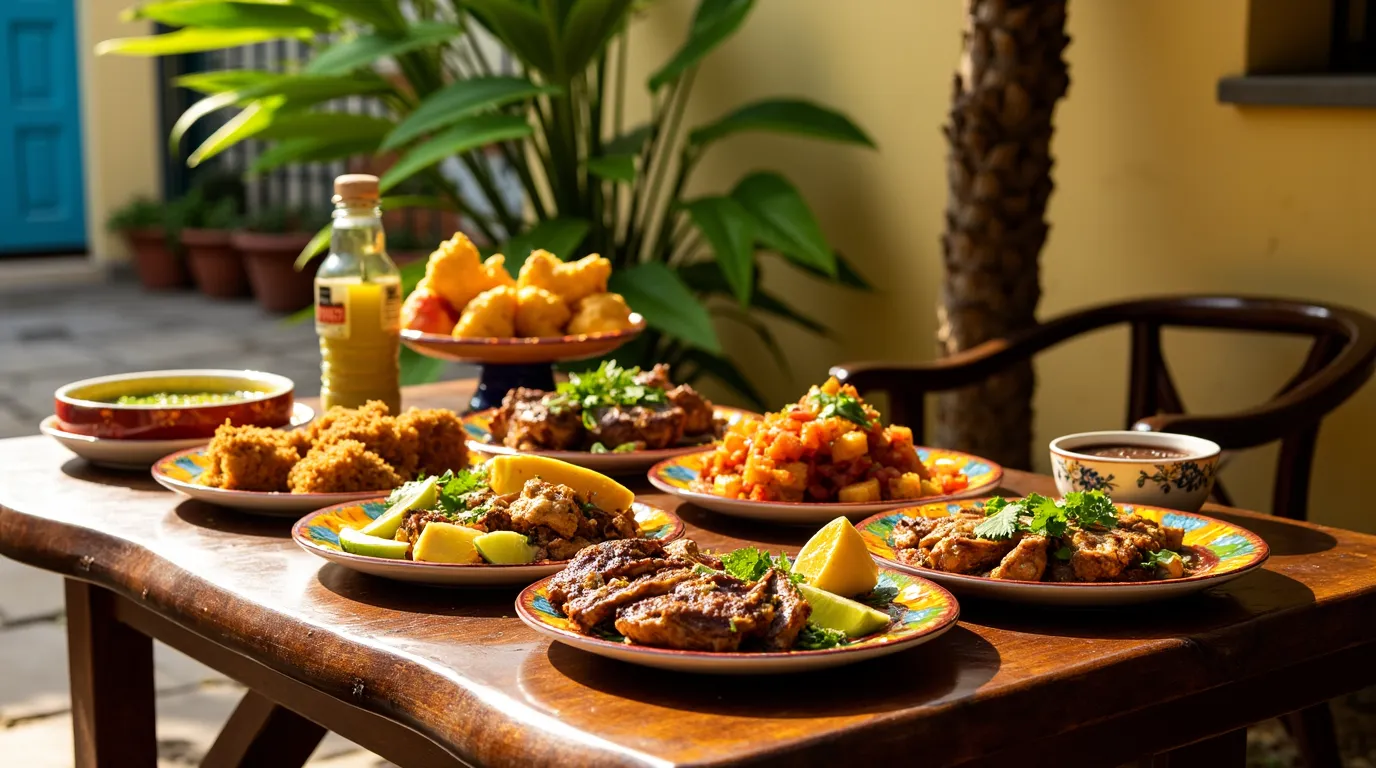Table of Contents
Table of Contents
Introduction
Cuban cuisine is a captivating tapestry of flavors, aromas, and traditions that have been woven together over centuries of cultural exchange and historical events. The island of Cuba, located at the crossroads of the Caribbean, has long been an intersection of different peoples and influences—ranging from the indigenous Taíno and Ciboney communities to the Spanish colonizers, African slaves, and later waves of immigrants from Asia and other parts of the world. Each of these groups has left a distinct imprint on the local food scene, shaping an extraordinary gastronomic identity that is at once simple, hearty, and deeply reflective of Cuba’s vibrant spirit.
When we talk about Cuban cuisine, we refer not only to a set of dishes but also to a way of life. There is a communal aspect that is immediately apparent: cooking in large pots to feed extended families and neighbors, gathering around hearty meals, and celebrating big and small life events through the sharing of food. The flavors in Cuban cooking are typically robust yet rarely overpowering, with the emphasis on fresh ingredients, lively seasonings, and a balanced layering of tastes.
In this article, we will delve into the multifaceted world of Cuban cuisine, exploring its historical roots, cultural significance, and distinctive regional variations. We will highlight key ingredients, must-try dishes, and the nuances that set them apart. Whether you are a seasoned traveler, a home cook eager to recreate authentic dishes, or simply a food enthusiast ready to embark on a new culinary journey, Cuban cuisine offers an inviting and mouthwatering experience. By understanding its origins and the traditions that inform it, you will gain a deeper appreciation for the food culture of this lively nation and hopefully feel inspired to bring a taste of Cuba into your own kitchen.
Culinary Context and History
Origins and Development Over Time
The birth of Cuban cuisine is a tale of cultural convergence. Before Spanish colonization in the early 16th century, indigenous tribes inhabited the island and subsisted on roots like yucca and malanga, tropical fruits, corn, and fish. These early culinary practices laid the groundwork for many staples still found in Cuban dishes today. When the Spanish arrived, they brought with them not only European techniques and seasonings—such as garlic, onions, and olive oil—but also a penchant for pork and beef. Meanwhile, the forced migration of African slaves introduced new cooking methods, vegetables, and, importantly, the art of slow-cooking stews that form a core component of many Cuban dishes.
Over time, the synergy of these influences shaped Cuban cuisine into something entirely distinct. The Spanish preference for hearty stews merged with the African reliance on tubers and spices, giving birth to the dishes that we now consider traditional. Furthermore, Chinese immigrants who arrived in the 19th century to work in sugar fields contributed rice-based dishes and stir-fry techniques, adding yet another dimension to the island’s culinary repertoire. Thus, Cuban cuisine grew from a base of local products, layered with ideas from Europe, Africa, and Asia, culminating in a food tradition that celebrates communal dining and the joy of gathering around flavorful dishes.
Key Historical Periods and Influences
Major events in the island’s history have shaped Cuban cuisine in tangible ways. The era of sugar plantations and African slavery in the 18th and 19th centuries solidified the use of certain roots, plantains, and cooking styles. Later, increased global trade introduced new produce and a variety of flavor enhancers. The transformation of Cuban society in the 20th century also impacted food availability. While political and economic fluctuations sometimes limited the variety of ingredients, the resilience of Cuban people ensured that resourceful cooking methods flourished—adapting recipes to whatever was available, without compromising on taste.
Some of the key turning points that influenced culinary habits include the sugar boom, which made sugarcane a cornerstone of the island’s economy, and the subsequent development of rum distillation, a byproduct of sugarcane processing. Rum, an iconic Cuban beverage, became an integral part of island hospitality and found its way into various desserts and glazes. The wave of modern tourism that began in the late 20th century also played a role, encouraging restaurants and paladares (privately owned small eateries) to innovate on traditional favorites and present them in more contemporary, fusion-inspired ways. All these historical layers come together in a cuisine that is as dynamic as it is rooted in tradition.
Regional Differences
Although Cuba is relatively small compared to many other countries, regional differences in cooking styles and preferred ingredients still exist. In the western provinces, including Havana and Pinar del Río, you are more likely to encounter dishes that emphasize pork and beef, as well as simple, rustic meals drawn from the Spanish tradition. Central regions, such as Villa Clara and Cienfuegos, highlight rice dishes and seafood, thanks to rich coastal resources. Meanwhile, the eastern part of the island (Oriente), which includes Santiago de Cuba and Guantánamo, bears the heaviest African influences, featuring robust seasonings, plantains, and hearty stews. This region is also known for using a more pronounced spice profile, reflecting the historical presence of African communities and Haitian migrants.
Geography plays a significant role in determining local tastes. Coastal towns lean heavily on fresh fish and shellfish, while inland provinces rely on livestock and tubers. Despite these variations, there is a unifying focus on communal dining and shared plates—a reflection of the Cuban cultural ethos that values friendship, family, and community above all. Regardless of where you are on the island, you’ll find that Cuban cuisine, at its heart, remains an inviting blend of history, creativity, and warmth.
Key Ingredients and Local Products
Emblematic Foods of Cuban Cuisine
When it comes to Cuban cuisine, a handful of ingredients stands out for their frequent appearances in local kitchens:
- Rice: Considered the foundation of many meals, rice in Cuban cuisine can be white (arroz blanco) or combined with beans (congri or Moros y Cristianos). Rice has historical connections to the Spanish paella and Chinese stir-fry traditions, both of which helped shape the island’s love affair with this staple grain.
- Beans (Black, Red, and Pinto): Beans appear in soups, stews, and the classic “rice and beans” combinations that are served with nearly every meal. Black beans, in particular, are a Cuban favorite, featured in the beloved dish frijoles negros (black bean soup).
- Pork and Chicken: Pork is arguably the most widely consumed meat, used in everything from hearty stews (such as potaje) to roasted whole (lechón asado). Chicken is a close second, especially for everyday family meals.
- Plantains and Bananas: Fried plantains (tostones or maduros) accompany many Cuban dishes, offering a sweet or savory contrast to the meal. Green plantains are typically flattened and fried for a crisp texture, while ripe ones are fried for a softer, caramelized taste.
- Tubers and Root Vegetables: Yuca (cassava), malanga, and sweet potatoes are prevalent, reflecting the indigenous and African heritage of Cuban cuisine. Yuca is often boiled, then drizzled with a garlic and citrus sauce called mojo.
- Citrus and Seasonings: Sour orange (naranja agria), lime, cumin, oregano, garlic, onion, and bell peppers (sofrito ingredients) define the characteristic seasoning base in Cuban cooking. These items bring a tangy or earthy flavor that sets Cuban dishes apart from other Caribbean cuisines.
- Seafood: Along the coasts, fish, lobster, and shrimp are popular, though economic restrictions sometimes limit their widespread availability. Nonetheless, seafood dishes like enchilado de camarones (shrimp creole) are prized for their hearty, tomato-based sauces.
Seasonality and Its Impact
Cuba’s tropical climate allows for the cultivation of fresh produce year-round. However, certain fruits and vegetables have peak seasons, influencing local cooking patterns. For instance, mangoes and guavas reach their ripest during the summer months, enriching the local dessert repertoire with fruity flans, jams, and pastries. During the cooler months (November through February), root vegetables and heartier produce become more prominent, reflecting a natural inclination to prepare soups, stews, and more substantial meals. This seasonality ensures that Cuban cuisine remains closely connected to the land, celebrating whatever is fresh and available in the market.
Purchasing Tips for Home Cooks
If you’re eager to recreate Cuban cuisine at home, start by sourcing the freshest possible ingredients:
- Local Markets: Look for Latin American grocery stores or markets that stock fresh plantains, yuca, malanga, and tropical fruits like mango, guava, and papaya.
- Online Specialty Retailers: If certain items—such as sour orange juice or specific spices—are difficult to find locally, consider reputable online merchants that specialize in Caribbean or Latin American products.
- Meat Selection: Opt for cuts of pork shoulder or fresh pork leg if you plan to roast lechón, and choose skin-on, bone-in pieces if you want the authentic crackling texture.
- Beans and Rice: Most supermarkets carry black beans, white rice, and other staples. Try to pick dried beans over canned for a more authentic flavor, though canned beans can be used in a pinch.
By sourcing the right products, you will get a taste that is closer to what you would experience on the island, capturing the essence of Cuban cuisine in your own kitchen.
Must-Try Traditional Dishes
National Flagship Dishes
Ropa Vieja
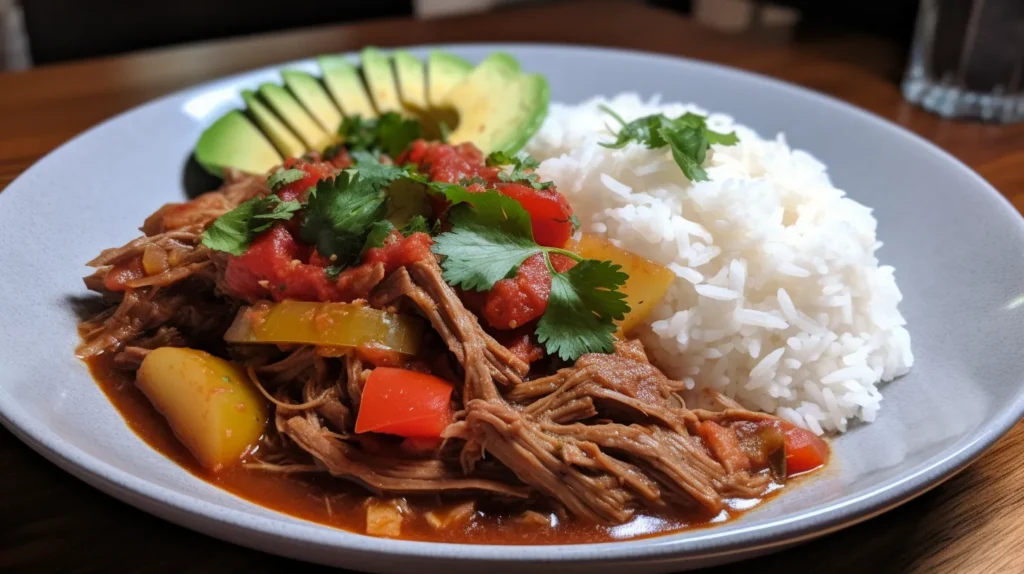
One of the most iconic dishes of Cuban cuisine, ropa vieja literally translates to “old clothes,” referencing the shredded texture of the meat in the stew. It’s typically made with braised flank steak or brisket cooked slowly with tomatoes, bell peppers, onions, garlic, and a medley of spices. Over time, the meat becomes so tender that it can be pulled apart into strands. Ropa vieja has Spanish origins but evolved in Cuba through local ingredients and seasonings. Served alongside white rice and black beans, it’s a hearty meal that embodies the comforting warmth of home-style Cuban cooking.
Lechón Asado
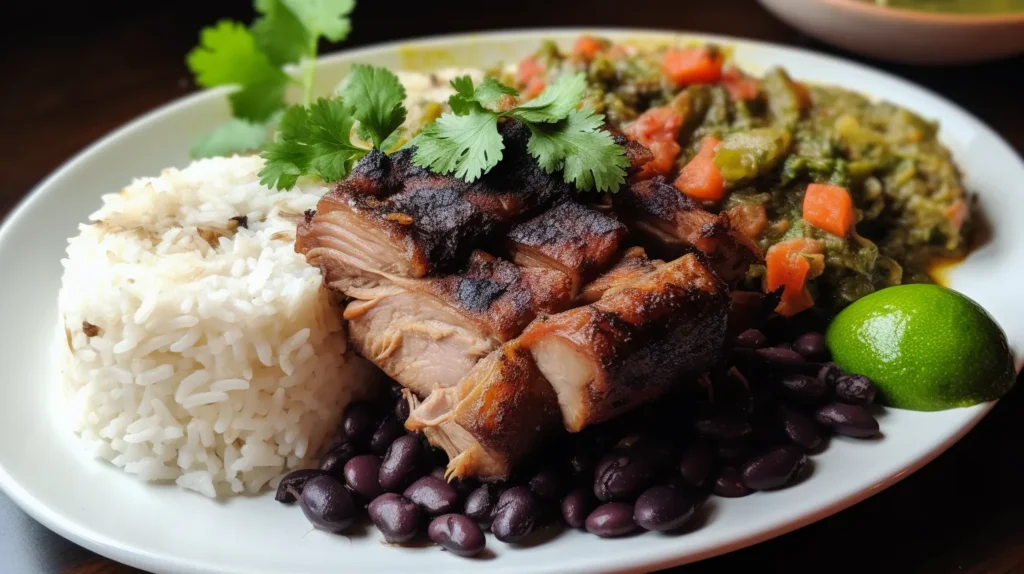
Roasted pork is a centerpiece of Cuban gatherings, particularly during festive occasions. The meat is often marinated in a mixture of sour orange juice, garlic, oregano, and cumin—commonly known as mojo—before being slow-roasted. Traditionally, lechón asado is prepared in a large outdoor pit, but you can recreate this at home using an oven or a grill. The crispy, crackling skin contrasts beautifully with the succulent, tender interior, making it a must-try for pork lovers.
Moros y Cristianos (Congri)
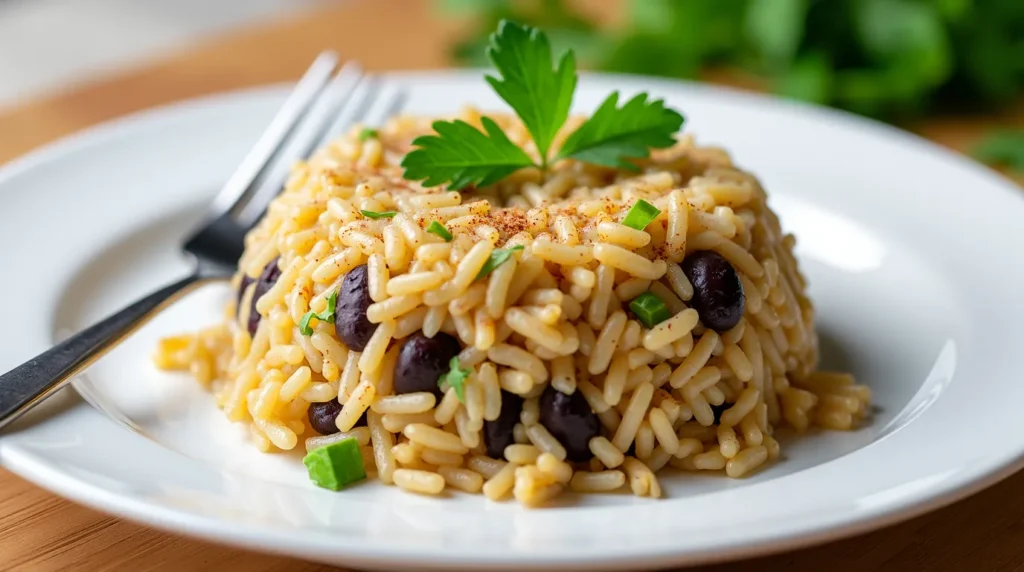
This dish combines black beans and white rice, cooked together so that the beans’ dark color “stains” the rice, hence the name “Moors and Christians,” a historical reference to medieval Spain. Moros y Cristianos is a staple on most Cuban tables, served with meat, plantains, or simply enjoyed on its own. Variations across regions may involve red beans instead of black, and some cooks add bacon or salted pork for extra flavor.
Picadillo a la Cubana
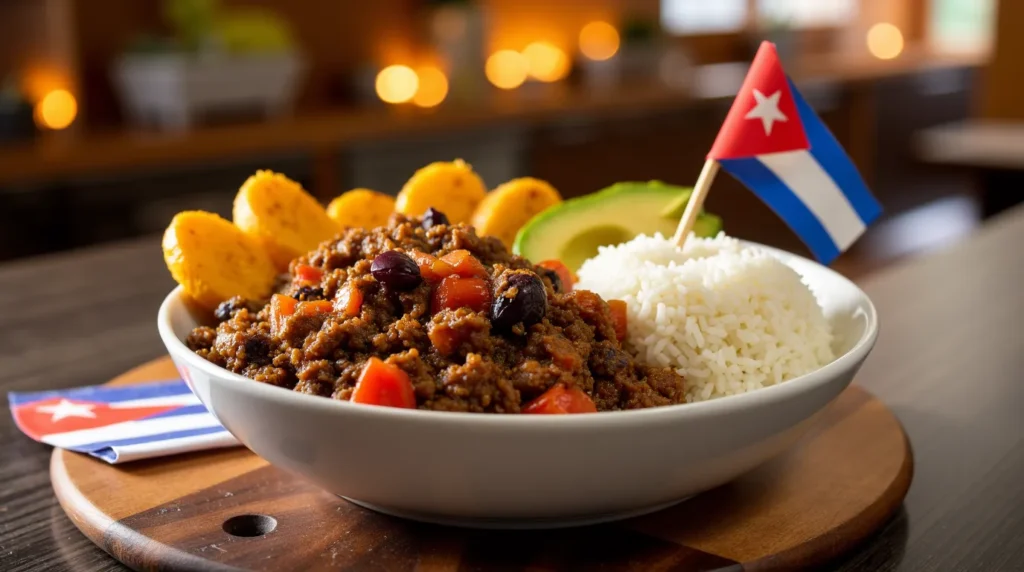
Picadillo is a ground-beef stew simmered with tomatoes, onions, garlic, and bell peppers, often augmented by raisins and olives for a sweet-and-salty contrast. This dish is a prime example of Cuban cuisine’s Spanish and African roots, melding savory, tangy, and sweet flavors into a single pot. It’s typically served with white rice and sometimes accompanied by a fried egg.
Tostones and Maduros
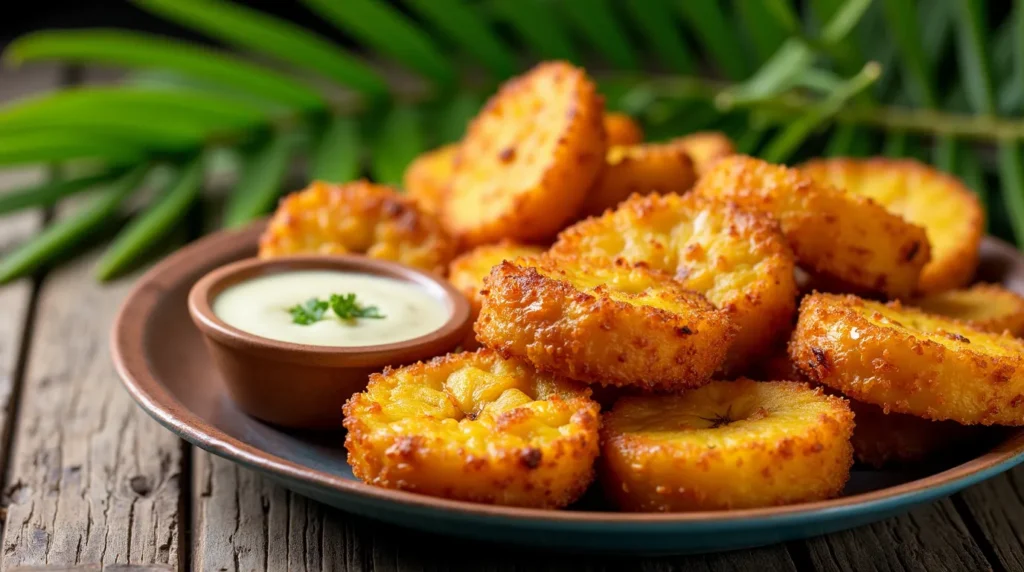
Plantains are integral to Cuban meals. Tostones are made from green plantains sliced and fried twice for extra crispness, while maduros use ripe plantains that offer a sweet, caramelized profile. Both variations provide a textural contrast to the more savory elements of a Cuban plate, balancing the meal in a delightful way.
Simplified Recipe: Cuban Black Bean Soup
Ingredients
- 1 cup dried black beans (soaked overnight)
- 2 tablespoons olive oil
- 1 small onion, finely chopped
- 1 green bell pepper, finely chopped
- 3 cloves garlic, minced
- 1 teaspoon ground cumin
- 1 bay leaf
- Salt and pepper to taste
- Optional: A splash of vinegar or sour orange juice
Instructions
- Drain and rinse your soaked black beans.
- In a large pot, heat olive oil and sauté onion, bell pepper, and garlic until they become soft and fragrant.
- Stir in the cumin, then add the black beans and enough water or vegetable stock to cover them by at least an inch.
- Add the bay leaf, bring to a boil, then reduce heat and let simmer for about one to two hours, or until the beans are tender.
- Season with salt, pepper, and a splash of vinegar or sour orange juice to brighten the flavor.
- Serve hot, accompanied by rice or toasted bread.
This simplified recipe captures the essence of a Cuban classic. In some regions, people mash a portion of the beans to create a thicker consistency, while others prefer a brothy texture.
Regional Variations
While most of these dishes can be found nationwide, local touches may differ. For instance, in Santiago de Cuba, you might find ropa vieja spiced with a bit more heat or served with slices of fried banana. Coastal regions might substitute fish or shellfish for the meat in certain stews, resulting in dishes like enchilado de pescado (fish creole). These subtle variations reflect the diversity of Cuban cuisine and ensure that no two meals are ever quite the same.
Defining Characteristics of Cuban Cuisine
Cuban cuisine stands out for its harmonious blend of savory, tangy, and subtly sweet flavors. While some Caribbean cuisines are known for spicy heat, Cuban dishes typically emphasize depth of flavor over spiciness. The frequent use of garlic, onions, and bell peppers—often sautéed together in a sofrito base—provides an earthy, aromatic backbone. Sour orange juice or lime frequently appears, imparting a bright, citrusy tang, while cumin and oregano add warmth and complexity.
One of the most characteristic elements of Cuban cuisine is its reliance on slow-cooking methods such as braising, simmering, and roasting. These techniques allow flavors to meld gradually, resulting in dishes that feel comforting and rich without being excessively spicy. The subtle interplay of sweet (from plantains and sometimes raisins or sugar) and savory (from meats, beans, and spices) is another hallmark.
For food enthusiasts eager to explore new frontiers, Cuban cuisine offers a gentler approach compared to piquant cuisines like Mexican or Thai. It appeals to those who appreciate a balance of flavors rather than a burst of heat. The creative use of relatively simple ingredients—combining them to produce dishes that are both budget-friendly and satisfying—also resonates with home cooks looking for approachable yet innovative recipes.
Tips and Highlights to Encourage People to Try This Cuisine
- Flavorful Yet Accessible: Because Cuban cuisine relies on slow cooking and layering of flavors rather than overwhelming spiciness, it’s friendly to a broad range of palates. This is ideal for those new to Caribbean or Latin American food.
- Cultural Immersion: Food in Cuba is deeply tied to dance, music, and community gatherings. Trying Cuban cuisine is not just about tasting new dishes; it’s an invitation to experience the convivial spirit of island life.
- Rich History: Each Cuban dish tells a story of cultural exchange—indigenous roots, Spanish colonization, African influence, and Chinese migration. Exploring Cuban cuisine can be a fascinating journey through centuries of global interactions.
- Adaptability: Many Cuban recipes can be modified based on dietary restrictions or ingredient availability without losing their essential character. Whether you’re vegetarian, pescatarian, or a meat lover, you can find a Cuban dish or adaptation that suits your taste.
- Simple Pleasures: A homemade Cuban meal doesn’t necessarily require gourmet ingredients or complicated techniques. With fresh produce, basic spices, and a bit of patience, anyone can replicate a taste of Cuba in their own kitchen.
Table Rituals and Customs
Typical Meal Structure
In Cuba, meals are generally communal affairs that reflect the importance of family and friendship in everyday life. Breakfast tends to be simple—a cup of strong Cuban coffee with toast (often buttered or pressed) or pastries, sometimes accompanied by fresh fruit juice. Lunch can be heartier, featuring rice and beans, a piece of meat or fish, and a small salad. Dinner is the main social meal of the day, bringing together family members after work or school. It often consists of one of the signature dishes such as picadillo or ropa vieja, served with rice, beans, and plantains.
Snacking or an afternoon break is not uncommon. The concept of merienda—an afternoon snack—can include a cup of coffee or a light sandwich. Rum-based cocktails like mojitos, daiquiris, or Cuba Libres may also appear in social gatherings, exemplifying the island’s festive spirit.
Etiquette and Local Traditions
When dining in Cuba, especially in private homes, it’s common to be offered more food even if you’re already full—refusing might be seen as impolite. Sharing dishes is widespread, reinforcing the communal aspect of mealtime. In more formal settings, it’s still polite to wait for the host’s signal before diving into the meal. Table manners in Cuba align with a relaxed Caribbean attitude, but courtesy and gratitude are deeply valued. Always compliment the cook and show appreciation if someone has gone out of their way to prepare a special dish.
Gestures to avoid include being visibly picky or wasting food, as resources can sometimes be scarce. Respect for the meal—and for the effort put into its preparation—is integral to dining customs in Cuba. If you visit during holidays or special celebrations, expect lively music, dancing, and an extended feast that can last for hours.
National Holidays and Culinary Specialties
Many of the important Cuban holidays and festivities center on sharing meals. During Christmas and New Year’s Eve, whole roasted pig (lechón asado) often serves as the main attraction, accompanied by yucca with mojo and rice and beans. Family reunions for birthdays, baptisms, and other milestones commonly feature large platters of roasted pork or chicken, as well as cakes infused with tropical flavors like guava or coconut. On significant religious occasions, some families may prepare simpler meals out of tradition, focusing instead on communal prayer and gatherings. Regardless of the holiday, food remains the unifying element that brings communities together, reflecting the generosity and warmth inherent in Cuban culture.
Modern Trends and Culinary Fusions
Influences From Abroad
In recent years, Cuba has opened up to more international tourism and exchange, bringing about subtle yet noticeable changes in its culinary landscape. Chefs and home cooks alike are experimenting with fusion concepts that blend the fundamentals of Cuban cuisine—like sofrito, plantains, and beans—with techniques and seasonings from global gastronomies. You might encounter a sushi roll made with marinated pork and fried plantains, or a pizza topped with mojo-seasoned shredded beef. Restaurants in cities like Havana have started offering tasting menus that reinterpret classic dishes such as ropa vieja in a more refined, haute-cuisine style.
Emerging Food Movements
As health-conscious eating and environmental awareness gain traction worldwide, Cuba is gradually embracing concepts like organic farming, farm-to-table dining, and vegetarian or vegan options. Small organic gardens, known as organopónicos, are increasingly popular in urban areas, providing fresh produce directly to local communities and restaurants. Many paladares (private, family-run eateries) highlight their use of locally sourced ingredients, celebrating the island’s agricultural wealth and helping diners appreciate the connection between farm and plate.
Vegetarianism is still relatively niche in Cuba, given the historical focus on meat-based dishes. Nonetheless, an increasing number of restaurants offer vegetarian versions of Cuban classics—like yuca con mojo without pork cracklings or congrí made with vegetable stock instead of meat. These variations open the door to a broader global audience and show the adaptability and creativity inherent in Cuban cooking.
Young Chefs and Contemporary Spins
The younger generation of Cuban chefs and food entrepreneurs are eager to revitalize and modernize Cuban cuisine, while still paying homage to its rich roots. Some have trained abroad and returned with fresh perspectives, combining cutting-edge gastronomic techniques with local traditions. These chefs might prepare a classic dish like picadillo but serve it as bite-sized croquettes garnished with microgreens, or offer a dessert that combines local fruit compotes with molecular gastronomy elements.
Paladares have become incubators for culinary innovation, as they are not bound by the same regulations as state-run establishments. This freedom allows for experimentation and paves the way for a new wave of restaurants that cater to both locals seeking novel dining experiences and tourists hungry for something beyond the usual fare. As these contemporary spins gain popularity, they not only keep Cuban cuisine evolving but also ensure the nation’s gastronomic heritage remains vibrant and relevant.
Conclusion and Call to Action
Cuban cuisine is a living testament to the island’s complex history, diverse cultural influences, and communal ethos. From the indigenous roots of tubers and tropical fruits, through the legacy of Spanish, African, and Chinese culinary traditions, to the modern transformations spearheaded by innovative young chefs, Cuban cuisine has continually evolved while maintaining its heartfelt simplicity and warmth. Whether you’re feasting on a plate of ropa vieja, savoring a crisp tostone dipped in garlic mojo, or delighting in a slice of guava-infused cake, every bite tells a story of resilience, creativity, and shared joy.
Throughout this article, we’ve explored the historical context that gave rise to Cuban cuisine, examined the key ingredients that make it so distinct, and highlighted must-try dishes that exemplify the island’s rich culinary tapestry. We’ve also delved into the defining characteristics that appeal to flavor seekers around the world, the table customs that emphasize community, and the modern trends shaping Cuba’s gastronomic future.
If you’re intrigued by what you’ve learned, consider trying your hand at a classic Cuban recipe in your own kitchen. Or, if you’re planning a visit to the island, make a point of seeking out local markets, family-owned paladares, and regions like the eastern provinces to experience the full breadth of flavors. Feel free to share your own experiences, whether it’s a success story about recreating lechón asado at home or a memorable meal you had in a coastal Cuban town. Your insights and questions keep this conversation alive and vibrant.
As a teaser for our next deep dive, we’ll be exploring the art of pairing rum-based cocktails with Cuban dishes—offering tips on how to elevate your dining experience even further. So stay tuned, keep experimenting in the kitchen, and continue discovering the culinary wonders that Cuba has to offer. Cuban cuisine is, above all, a celebration of life—one best enjoyed in the company of good friends, good music, and, of course, plenty of delicious food.

